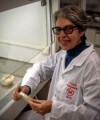Actualidad
Photosensitization of Riboflavin Reduces Susceptibility to Gray Mold in Postharvest Kiwi
Riboflavin Excitation with Light Around 365 to 445 nm Produces Singlet Oxygen
Phytopathogens, including bacteria, fungi, and viruses, cause significant economic losses in fruits and vegetables during their development and ripening. Gray mold caused by Botrytis cinerea has been one of the most widespread phytopathogens, affecting a wide range of host species, including kiwi.
The fungus prefers soft tissues such as fleshy fruits, causing decay, and it spreads easily to neighboring fruits. Therefore, fleshy fruit becomes more susceptible to gray mold as it progressively ripens before senescence, with a different infection dynamic compared to vegetative tissues.
Plant Immunity Systems
Plants have developed two types of innate immunity systems: pathogen-associated molecular pattern-triggered immunity and effector-triggered immunity. These involve specific recognition by receptors located on the plasma membrane for early rapid alarms and host resistance proteins to limit subsequent pathogen spread.
These protections are also known as systemic acquired resistance, typically occurring during early pathogen localization, with the accumulation of salicylic acid and pathogenesis-related proteins.
Additionally, another defense system is induced systemic resistance, dependent on jasmonic acid or ethylene, where the immune system is sensitized to enhance resistance responses to pathogen attacks, with biotic and abiotic origins.
Several potential mechanisms underlying plant immunity have been proposed, including oxidative stress, energy balance, phytohormones, jasmonic acid, and salicylic acid signaling.
Strategies Against Gray Mold
Intensive studies have been conducted on how to deal with gray mold, including physical, chemical, biological, and combined measures. Protective effects include lethal or direct inhibitory methods such as cold atmospheric plasma treatments.
Riboflavin as a Photosensitizer
Among the many proposed strategies, photosensitizers have received significant attention in recent decades.
Riboflavin (known as vitamin B2), used as a food additive, is generally recognized as safe by the USFDA. It is abundant in various plant species and is employed in dietary supplements and for controlling inflammatory diseases.
Riboflavin is involved in a wide range of biological processes as a precursor to flavin cofactors, flavin mononucleotide (FMN, functioning as a prosthetic group in various oxidoreductases, such as NADH dehydrogenase), and flavin adenine dinucleotide (FAD, a redox cofactor and prosthetic group involved in several key metabolic reactions).
The positive functions of riboflavin in fruits and vegetables have been suggested. For instance, it has been applied to control postharvest diseases, improving quality and regulating ripening.
In particular, as a photosensitizer, riboflavin is excited with light around 365 to 445 nm, producing singlet oxygen* and superoxide anion radical, which have been used to target microorganisms.
Previous studies have shown that photosensitized riboflavin effectively controls bacterial contamination in freshly cut apples, with protective effects related to increased phenolic levels and antioxidant systems.
Controlling Botrytis in Kiwi
Kiwi is an economically important fruit species with a global production of around 4.5 million tons in 2021 (FAO, http://www.fao.org/faostat/en/#data/QC). However, there has been a 20% to 30% loss in global yield due to postharvest diseases, with gray mold caused by Botrytis cinerea being the most prevalent and devastating.
In response to the adverse effects of chemical fungicides on the environment, eco-friendly reagents, including photosensitizers for disease control, have become a focus of attention for postharvest disease protection. Although photosensitized riboflavin has shown protective effects against several causal agents, mostly bacteria, its effects on gray mold remain an area of limited exploration.
Recent research has demonstrated that an elevated antioxidant system with photosensitized riboflavin confers broad-spectrum resistance to fungal pathogens, including B. cinerea, in fleshy fruits.
The impacts on gray mold susceptibility in postharvest kiwis at 25°C for 8 days were investigated, and the underlying mechanisms related to oxidative stress, energy, jasmonic acid, and sugars were evaluated.
Morphological results showed that photosensitized riboflavin reduces the severity of gray mold.
Biochemical and molecular assays indicated that riboflavin enhances energy status, jasmonic acid biosynthesis, glucose accumulation, and improves oxidative stress, regardless of photosensitization. In particular, photosensitized riboflavin exhibits three distinct effects: greater impacts on oxidative stress and jasmonic acid production, sustained electron transport chain activity with enhanced membrane lipid peroxidation without increasing energy levels, and delayed early sucrose degradation.
Potential of Photosensitization-Induced Responses
Together, these findings underscore the crucial role of photosensitization-induced responses, involving early stimulation of jasmonic acid biosynthesis and commitment to sucrose degradation, in enhancing gray mold resistance in kiwi.
*Singlet oxygen molecules, in their ground state (lowest energy), have two unpaired electrons in their highest-energy molecular orbitals. Singlet oxygen molecules, in contrast, have two paired electrons that can be in the same orbital or in different orbitals. It is an extremely reactive molecule that can be generated directly by the reaction of hydrogen peroxide (H2O2) with sodium hypochlorite (NaOCl) [1] or indirectly by energy transfer from a light-excited molecule. The latter is more commonly used due to the simplicity of controlling the singlet oxygen generation process.
Molecules such as porphyrins, chlorophylls, methylene blue, and many other organic molecules can generate singlet oxygen through energy transfer when irradiated with light at the appropriate wavelength.
Sources
Long, Y.; Sun, Y.; Zhou, B.; Zhu, G.; Chen, X.; Qi, Y.; Wang, K. (2024). Photosensitization of riboflavin reduces the susceptibility to gray mold in postharvest kiwifruit. Postharvest Biology and Technology, 212:112836
Image
https://pt.wikipedia.org/wiki/Oxig%C3%A9nio_singleto Accessed on 05/10/2024.













